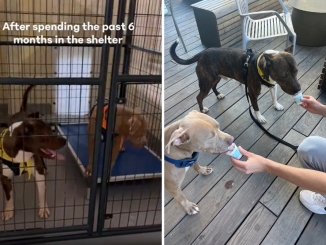Results indicated that not only can dogs detect Covid faster, but they can also do so in a non-intrusive manner – so no need to swab your throat or nose

Dogs can detect Covid-19 faster and more accurately than a PCR test, a new study shows.
Researchers looked at the ability of canines to recognise the virus and its variants, even when they are obscured by other viruses, like those from common colds and flu.
More than 400 scientists from over 30 countries contributed to the study as well as 147 scent dogs, according to the findings published in the Journal of Osteopathic Medicine.
After analysing many studies covering both field and clinical experiments, Professor Dickey and Junqueira found that dogs who are trained to sniff out scents are “as effective and often more effective” than antigen tests.
A total of 53 dogs were trained to sniff out Covid scents, while 37 were not and scientists found that the dogs that were not trained were in some cases “slightly superior” to those that were pre-trained.
“The previously untrained dogs have the advantage that they are not as prone to indicating on scents other than the Covid–19 associated scent,” the paper said.
The results indicated that not only can dogs detect Covid faster, but they can also do so in a non-intrusive manner. This means you won’t need to put a swab in your throat or nose.
How can dogs detect the virus?
This essentially comes down to the dog’s highly evolved nose with its ability to sense out smells quicker.
Dogs possess up to 300 million olfactory receptors in their noses, compared to about six million in humans. And the part of a dog’s brain that is devoted to analysing smells is about “40 times greater” than humans. Canines also have ‘neophilia’, which means they are attracted to new and interesting odours
And so, with all these enhancements, dogs can detect very low concentrations of odours associated with Covid infections.
“They can detect the equivalent of one drop of an odorous substance in 10.5 Olympic-sized swimming pools,” Professor Dickey said. “For perspective, this is about three orders of magnitude better than with scientific instrumentation.”
Scientists also found that in some cases, the animals were also able to detect the virus in pre-symptomatic and asymptomatic patients, “whose viral load was too low for conventional tests to work.”
Professor Dickey has said that dogs can also differentiate Covid and its different variants in the presence of other respiratory viruses. This included the common cold or flu.
“They’re much more effective. In fact, one of the authors that we quote in the paper commented that the RT-PCR test is not the gold standard anymore. It’s the dog. And they’re so quick,” he added. “They can give you the yes or no within seconds if they’re directly smelling you.”

How was the study conducted to see if dogs can really detect Covid-19?
In some studies, the dogs gave a person a quick sniff, sitting down to see if the person has Covid. In another study, the dog was given a sweat sample to smell for a few minutes.
The press release has said that scent dogs, such as beagles, basset hounds and coonhounds are the ideal candidates for sniffing out the virus, given their “natural tendencies to rely on odours to relate to the world.”
But the studies which the researchers analysed showed a variety of dogs were up for the challenge and were able to sniff out the Covid odour. With a few weeks of training, puppies, older dogs, purebred and mixed breeds, both male and female were able to sniff such odours out and “all performed admirably,” the Eureka Alert press release said.
Although there has been success with dogs detecting such viruses, researchers believe there are still many challenges with using dogs for medical diagnoses.
“There’s quite a bit of research, but it’s still considered by many as a kind of a curiosity,” said Professor Dickey.
In conclusion, Professor Dickey and Junqueira said after reviewing the studies, believe that scent dogs deserve “their place as a serious diagnostic methodology that could be particularly useful during future pandemics, potentially as part of rapid routine health screenings in public spaces.”
“Perhaps, most importantly, we argue that the impressive international quality and quantity of COVID scent dog research described in our paper for the first time, demonstrates that medical scent dogs are finally ready for a host of mainstream medical applications,” they added.
Till these kind rescuers showed up, a stray puppy with his ear severed cried out for help.

With increased interest in animal welfare, groups and institutions are springing up all over the world to rescue and protect animals in distress. This heartwarming story is about a dog rescued from the streets by an Indian animal protection organization. The puppy was badly injured in one ear when it was discovered. His appearance, crying out in agony, breaks the rescuer’s heart. However, the puppy’s behavior changed dramatically after that.
A white dog was discovered on the streets of India one day. The rescuers quickly phoned Animal Aid, an Indian charity that saves and protects animals.

What sort of dog is requesting assistance… Rescue personnel that arrived on the spot were misled. When they noticed the puppy, they took a brief pause.
One ear of the puppy, who was whimpering and sitting on the road’s edge, hung down and was nearly ripped.

A puppy screaming in agony and dangling his bloodied ears. Because it hurt so much, he wailed and tossed his head from side to side. The rescuer approaches the puppy gently and quietly.
The dog, on the other hand, was terrified and in pain. She wept and retreated from Zurizuri and her rescuers.

Close inspection indicates that the hair is sticking to the surrounding dust, grass, and dust.
The rescuer provided food to the dog, but the puppy was in such much pain that he refused any food.
In the face of such a dog, rescue workers never give up. I wish to relieve this child’s pain. She might have other injuries.

He took his time approaching the puppy and wrapped a blanket around his body. The puppy was then wrapped in a blanket and transported to the Animal Aid center.
The puppy was promptly sedated upon arrival at the institution, and veterinarian care commenced.

His ears, which are only held together by a sliver of tissue, are medically removed and meticulously sutured. After the dramatic rescue play, the puppy was finally able to rest calmly.
“Banjo” was subsequently given to the dog. In his case, he has only two ears, which is a dog trait. He was also two weeks post-surgery.
Banjo has undergone a significant transformation!
Banjo’s presence two weeks later thrilled the audience. When Banjo was discovered, he was absolutely scared and shaking.
He is now going around and playing with other dogs and people.

The puppy’s mischievous side is also coming to life. Nobody who discovered him realized he was such a fun and attractive dog at the time.

Some people may ask if it’s okay for a dog to be deaf in one ear. In the case of Banjo, though, he seemed indifferent about losing one of his ears.

I hope Banjo, who has made a moving change, will continue to live happily.



Leave a Reply